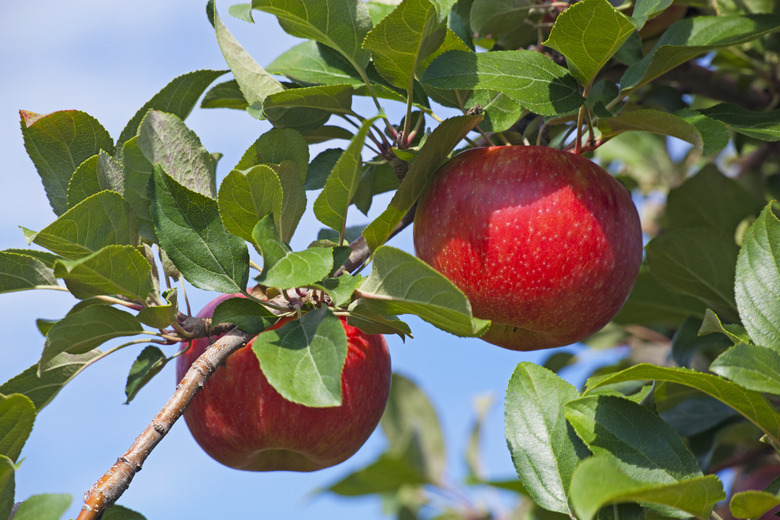How To Grow Honeycrisp Apple Trees
We may receive a commission on purchases made from links.
Crisp and sweet, Honeycrisp apples (Malus pumila 'Honeycrisp') are a delicious option to add to your home orchard. These sun-loving apple trees are relatively easy to grow in cooler climates. Giving your Honeycrisp tree the proper care helps you enjoy a bountiful harvest.
Basics of Honeycrisp Apple Trees
Basics of Honeycrisp Apple Trees
Honeycrisp apple trees exist as dwarf or semi-dwarf varieties. Plant them in your backyard for fresh, late-summer apples every year. Plant bareroot Honeycrisp trees in the spring. Trees sold planted in a container or with balled and burlap-wrapped roots should be planted in the spring or fall.
This apple tree variety is hardy in U.S. Department of Agriculture plant hardiness zones 3 to 7. Plant dwarf trees where space is limited; they grow to a height and width of only 10 feet. Semi-dwarf Honeycrisp trees grow to 15 feet high and wide. Once they reach two to five years old, Honeycrisp trees produce apples about 3 inches tall with dappled red skin and mild, sweet, off-white flesh.
Honeycrisp Apple Tree Pollinators
Honeycrisp Apple Tree Pollinators
When growing Honeycrisp apples, plant another apple tree variety along with Honeycrisp trees for a more abundant crop. They can produce some fruit on their own but do better with a pollinator nearby. 'Campbell Spur' red delicious (Malus pumila 'Campbell Spur' or 'Starkrimson'), hardy in USDA zones 4 to 8, and 'Griffith' golden delicious (Malus pumila 'Griffith' or 'Stark Blushing Golden'), hardy in USDA zones 5 to 8, are both effective pollinators for Honeycrisp. Both exist in dwarf or semi-dwarf sizes just like Honeycrisp.
Sun, Soil and Spacing
Sun, Soil and Spacing
Plant Honeycrisp trees in fast-draining soil with a pH of 6.0 to 7.0 and a full sun exposure. The trees grow best in loamy soil but will grow in sandy loam and light clay, as long as it drains quickly. Plant dwarf trees 10 feet apart and semi-dwarf trees 15 feet apart. Pollinator trees should be planted within 50 feet of Honeycrisp trees.
Watering New Honeycrisp Trees
Watering New Honeycrisp Trees
Water Honeycrisp trees as often as necessary to keep the rootball lightly moist for the first three months after planting. Apply the water directly above the rootball. Spread 2 to 3 inches of organic mulch over the soil directly above the root zone. Remove weeds and grass that grow within 1 foot of the trunk.
Don't put mulch right up against tree trunks. Instead, keep it about 4 to 6 inches away. Wet mulch against the trunk will encourage disease.
Watering Established Trees
Watering Established Trees
Water Honeycrisp trees when the top 3 to 4 inches of soil becomes dry after the first few months. Check for moisture with a soil probe, a thin, 1/4- to 3/8-inch wide metal rod. Apply water in the area from 6 inches away from the trunk to a few feet beyond the "drip line" or outer edge of the branches. Water until the soil is moist to a depth of 1 1/2 feet for the first two years. Increase the watering depth to 2 1/2 feet in the third year then 3 feet from the fourth year on.
Honeycrisp Fertilizer Requirements
Honeycrisp Fertilizer Requirements
Apply fertilizer to your apple trees based on the results of a soil test. In absence of a soil test, give Honeycrisp trees 1/2 cup of 20-5-10, 1 cup of 10-6-4, or 2 cups of 5-10-10 fertilizer after they begin growing vigorously if they were planted in the spring. Spread it in a 2-foot-wide circle around the tree a few inches away from the trunk. If they were planted in the fall, wait until the following spring to begin fertilizing them.
When the ground thaws, sprinkle 1/4 pound of 20-5-10, 1/2 pound of 10-6-4, or 1 pound of 5-10-10 fertilizer around the trees beneath the drip line. Give double that amount in the second year. Increase the amount by half each year from the third year on. For example, in the spring of the third year, Honeycrisp trees should get 3/4 pound of 20-5-10, 1 1/2 pounds of 10-6-4, or 3 pounds of 5-10-10. Reduce the amount of fertilizer by half if the trees aren't surrounded by grass, and always fertilize trees in the spring after the ground thaws.
Secrets to Bigger, Better Apples
Secrets to Bigger, Better Apples
Pick spring flowers off the trees for the first two years. This will prevent fruit set and let the trees put that energy into growing stronger. Remove about half the flowers in the spring of the third year so the trees will produce a small crop. Pinch the flowers and pull them off by hand evenly on all of the branches to avoid one or two overloaded branches.
From the fourth year on, pick some of the apples early so apples left to mature will be bigger and better. Apple trees naturally drop some apples in late spring a few weeks after they form to reduce their burden. Remove more apples right after this happens, leaving only one apple per spur. The spur is the little bit of stem where apples form.
